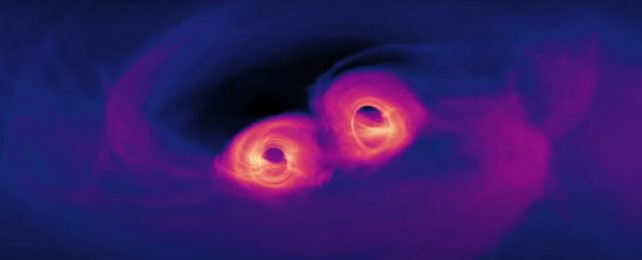The weird behavior of a galaxy around a billion light-years away suggests that it might contain one of the most highly anticipated events in modern astronomy.
Fluctuations in light from the center of the galaxy SDSS J1430+2303 look suspiciously like a pair of supermassive black holes with a combined mass of around 200 million Suns destined for an imminent collision with each other.
"Imminent" in cosmic terms can often stretch on for whole lifetimes. Fortunately in this case, astronomers predict that if the signal is indeed the result of colossal black holes they will merge within the next three years.
It may be our best shot yet to see two supermassive black holes collide… but we still don't know for sure if that's what is going on at the heart of J1429+2303. Scientists advise that we continue watching the strange galaxy to see if it can be conclusively identified.
The first detection of colliding black holes back in 2015 launched a bold new era for astronomy. Since then, many more detections have been made thanks to the gravitational waves these massive events send rippling through space-time.
To date, almost all of these mergers have been binary pairs of black holes with masses comparable to individual stars. There's a very good reason for this. LIGO and Virgo, the gravitational wave instruments responsible for the detections, are designed for this mass range.
The more ponderous ripples generated by inspiralling and colliding supermassive black holes, in the range of millions to billions of times the mass of the Sun, are in a frequency range too low for our current observatories.
Still, the merger of a pair of supermassive black holes would be a freaking sweet thing to observe. Even without a detector capable of sensing low frequency gravitational waves, scientists expect to see an immense outburst of light across the spectrum.
The data packed into that outburst could tell us so much about how these events play out. We're not entirely sure how supermassive black holes get so big, but there are a few clues to suggest that one mechanism is binary mergers.
We know that galaxies have supermassive black holes in their centers, and we've observed not just pairs and groups of galaxies colliding, but supermassive black holes circling each other in mutual, decaying orbits in the centers of these post-merger galaxies. These are inferred from oscillations in the light emitted from the galactic center of these galaxies, on regular timescales that suggest an orbit.
This brings us back to J1430+2303. Earlier this year, a team of astronomers led by Ning Jiang of the University of Science and Technology of China uploaded a paper to preprint server arXiv, describing some really strange behavior. Over a period of three years, the oscillations in the galactic nucleus grew shorter and shorter, from a time period of about a year, down to just one month.
However, it's not entirely clear that what is happening at the heart of J1430+2303 is the result of a black hole binary at all, never mind one that is about to kaboom. Galactic nuclei are strange places, throwing out signals that are difficult to interpret, meaning it's possible something else may be causing the variability in the heart of J1430+2303.
To try to get to the bottom of the matter, astronomers turned to X-ray wavelengths. Using data from a range of X-ray observatories, covering a time period of 200 days, a team led by Liming Dou of Guangzhou University in China has attempted to identify high-energy signatures that we would expect to see in a close supermassive black hole binary on a decaying orbit.
They did see variations in the X-ray light emitted by the galaxy, as well as a type of emission associated with iron falling onto a black hole, which the team detected with a 99.96 percent confidence level from two different instruments. This emission can be associated with binary supermassive black holes; however, the team could not measure the "smoking gun" characteristics that would confirm a black hole binary.
Analysis of radio observations published in July were also inconclusive. So it appears we're still not 100 percent sure about what's happening with J1430+2303.
What we are able to state with confidence is that something very strange seems to be happening at the galaxy's center. Above all, it's a mystery, and a very juicy one; whether it's a supermassive black hole binary on the brink of collision or not, J1430+2303 seems to warrant closer, more detailed attention.
The paper has been accepted for publication in Astronomy & Astrophysics, and is available on arXiv.
